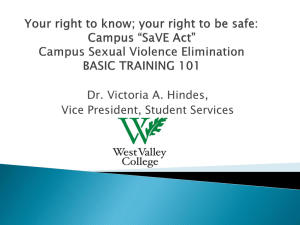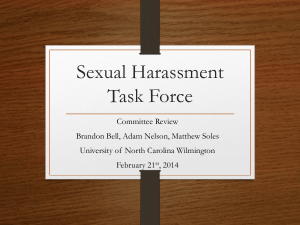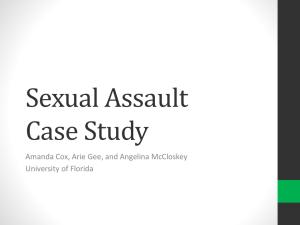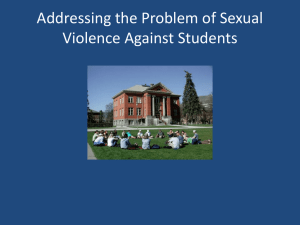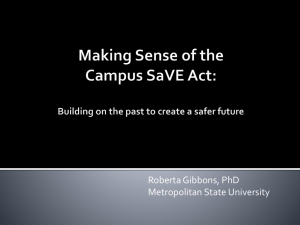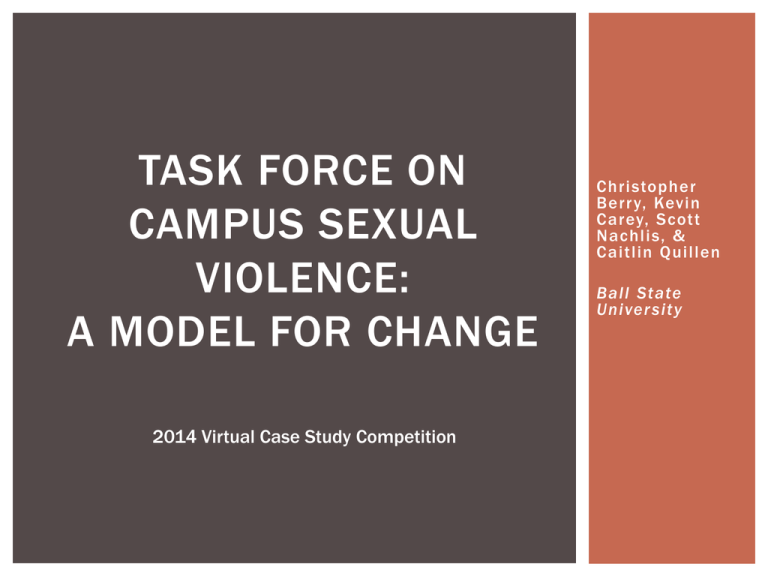
TASK FORCE ON
CAMPUS SEXUAL
VIOLENCE:
A MODEL FOR CHANGE
2014 Virtual Case Study Competition
Christopher
Berr y, Kevin
Carey, Scott
Nachlis, &
Caitlin Quillen
Ball State
Univer sity
WHO WE ARE
Christopher Berry works in the Office
of Student Rights and Community
Standards. He did his undergraduate
work at Indiana Wesleyan University.
Kevin Carey works with Fraternity
and Sorority Life in the Office of
Student Life. He hails from Illinois
Wesleyan University.
Caitlin Quillen is an Assistant
Residence Hall Director in Housing
and Residence Life, and completed
her undergraduate work at The Ohio
State University.
Left to right: Christopher Berry, Kevin Carey, Caitlin Quillen, and Scott Nachlis
Scott Nachlis works with Excellence
in Leadership in the Office of
Student Life. He did his
undergraduate work at Ithaca
College.
ABC UNIVERSIT Y
4 year
Public Institution
Mid-size
Midwest
Residential Campus
Division I Intercollegiate Athletics
Fraternity and Sorority Life
Cuwfalcons.com (2014)
PRESENTATION OUTLINE
Call to action
Definitions of Terms and Focus
Kotter’s Theoretical Change Model (1996)
Definition and Implementation Strategies of Each
Stage
Future Action
References
THE PROBLEM
1 in 5
college women will be
the victim of rape or
attempted rape
90%
of college women
knew their attacker
<5%
of attempted or
completed rapes are
reported
Fisher, Cullen, & Turner (2000)
WHAT WE MEAN
Sexual Violence
includes:
Domestic violence
Relationship
Violence
Sexual Assault
Sexual Harassment
Stalking
“The sexual
harassment of
students, including
sexual violence,
interferes with
students’ right to
receive an education
free from
discrimination and, in
the vase of sexual
violence is a crime.”
Office for Civil Rights (2011)
KOTTER’S EIGHT STEP CHANGE MODEL
1. Establish Urgency
2. Create a Guiding
Coalition
3. Develop a Vision
and Strategy
4. Communicate the
Change Vision
5. Empower Others to
Act
6. Generate ShortTerm Wins
7. Build on Progress
8. Make the Changes
Stick
Kotter (1996)
STEP ONE:
ESTABLISH URGENCY
Theoretical Change Model
Action Steps
Move individuals away
from complacency
Target specific student
groups to take ownership
Raising awareness of
problem
Create marketing campaign
for communication and
awareness
Understanding and
committing to change
Engage student participation
STEP TWO:
CREATE A GUIDING COALITION
Theoretical Change Model
Action Steps
Need for buy-in from
numerous individuals
Solidify stakeholders for
task placed upon institution
Stakeholders adding
efforts to change
Introduce university offices
involved with change
movement
Essential to bringing
power and credibility
to change movement
Continue collaboration with
student groups
CREATE A GUIDING COALITION
Task Force comprised of Stakeholders
Vice President for Student Af fairs (Convener)
Of fice of Student Conduct
Of fice of Student Life
Of fice of Housing & Residence Life
Intercollegiate Athletics
Counseling Center
Health Center
Orientation Services
Public Safety/University Police
Student Government Association Representative
Provost/Academic Af fairs Representative
CREATE A GUIDING COALITION
Targeted Campus Groups for Involvement
Victims and Survivors
Residence Hall Students
Intercollegiate Athletics
Fraternity and Sorority Life
Faculty and Staff
STEP THREE:
DEVELOP A VISION AND STRATEGY
Theoretical Change Model
Action Steps
Involves most planning STEP UP & STAND OUT
and organization
Campaign Call to Action Slogan
Expertise of coalition
members comes in
handy
Part 1: Vision
Vivid mental picture of
where the institution will
be in the future
Campaign to end sexual
violence on campus
STEP THREE:
DEVELOP A VISION AND STRATEGY
Theoretical Change Model
Action Steps
Institution takes action Overarching Goal:
to make change happen STAND UP & STEP OUT aids in the
Vision of future to
become reality
Requires knowledge,
planning, and goals
primary prevention and awareness
of sexual misconduct through
training, facilitative education, and
relationship building among
community of supportive peers
Collaboration with Offices on
Task Force and student
involvement
STEP THREE:
DEVELOP A VISION AND STRATEGY
STAND UP
Publically advocate
against sexual violence
through:
Awareness
Prevention programming
STEP OUT
Taking action against
sexual violence
S
TE
P
OU
T!
STEP THREE:
DEVELOP A VISION AND STRATEGY
Response to Victims and Survivors
Conduct System
Creation of Victim’s Advocate Position
Support Group
Counseling
Survivor Stories
#SUSO
STEP THREE:
DEVELOP A VISION AND STRATEGY
Bystander Intervention Training
Develop ways to increase awareness of sexual assault, such as
learning to make observations and recognizing warning behaviors
that may require intervention.
Teach the appropriate skills to intervene safely and effectively, in
both direct and indirect ways
Target groups who would receive training:
House and Residential Life Staff
Fraternity and Sorority Life Members
Student Athletes
#SUSO
STEP THREE:
DEVELOP A VISION AND STRATEGY
Fraternity and Sorority Life SAFE Homes
Sexual Abuse Free Environment (SAFE)
SAFE House
Identify 1 Fraternity and 1 Sorority Chapter Facility
Provides peer education to broaden awareness of sexual violence
Aids in the prevention of sexual assault
At public parties, members of chapters who participate
provide “SAFE Squad” to make sure sexual violence does not
occur.
In future, all chapters that are housed would become SAFE
House trained.
#SUSO
STEP THREE:
DEVELOP A VISION AND STRATEGY
Males Athletes Against Violence
MAAV is an ef fort to involve men so there can be an
understanding that violence is very much a “man’s issue”
Creation of Student Coordinator of MAAV
Student Organization
Participates in educating all men on campus related to sexual
violence and White Ribbon Campaign
Creation of promotional video of male athletes to raise
awareness and show support of Stand Up and Step Out!
#SUSO
STEP THREE:
DEVELOP A VISION AND STRATEGY
Marketing Campaign based on Step Up and Stand Out!
Marketing Materials would be distributed at Orientation,
Bystander Intervention, Sexual Violence Student Symposium,
and through campus initiatives.
Window clings for office, cars, and residential door
Buttons/Ribbons for backpacks and coats
Poster campaign for building, residence halls, and Greek
houses
Social Media campaign with Facebook and Twitter accounts,
using the Stand Up and Step Out (SUSO)
#SUSO would create a prevention and awareness culture on
campus
Website would be created with all initiatives stated
#SUSO
STEP THREE:
DEVELOP A VISION AND STRATEGY
Sexual Violence Student Symposium
An opportunity to have a panel discussion with survivors and
victims
Provide educational resources
Opportunity to be Bystander Intervention trained
Launch of marketing campaign
Cross-collaboration among departments and of fice on campus
to provide educational experiences during symposium
Annual Stand Up and Step Out (#SUSO) Support Walk
“Standing up to recognize survivors and victims and stepping out to
end sexual violence!”
#SUSO
STEP THREE:
DEVELOP A VISION AND STRATEGY
Orientation Services
Utilize Alchol.edu and Haven software created by EverFi to
educate incoming first year students on alcohol use and
sexual violence
Introduce services for survivors and victims on campus
#SUSO campaign materials provided to them to show support
#SUSO
STEP FOUR:
COMMUNICATE THE CHANGE VISION
Theoretical Change Model
Action Steps
“The real power of a
Implement STAND UP &
vision is unleashed only
STEP OUT social media
when most of those
campaign
involved. . . Have a
common understanding
of its goals and
Communicate with all
directions” (Kotter, 1996,
students on campus through
p. 85).
Actively communicate
vision and strategy
prevention and awareness
strategies
STEP FIVE:
EMPOWER OTHERS TO ACT
Theoretical Change Model
Action Steps
Individuals with least
amount of power must
be empowered to act
Through workshops,
motivate all campus
community members
involved to act
Individuals need
training in new skills
and policies
Required training for all
students to participate in
change movement
System needs to be
aligned to new vision
Provide new policies on Title
IX to Faculty and Staff
STEP SIX:
GENERATE SHORT-TERM WINS
Theoretical Change Model
Action Steps
Provide evidence that
Vital to prove to
sacrifices are worth it
stakeholders that the
Reward change agents for their
vision is important
hard work
Help fine-tune vision and
strategy
Undermine cynics and resisters
If change process takes
too long, individuals may Keep high-level administrators
on board
give up
Build momentum for the future
STEP SEVEN:
BUILD ON PROGRESS
Theoretical Change Model
Action Steps
Natural counterpart to
celebrating short-term
wins
Comply with future
legislation and regulations
Effective change
requires time
Evaluate and Celebrate all
successes
Reestablish urgency so Continually engage task
force and students in piloted
momentum is not lost
programs
STEP EIGHT:
MAKE THE CHANGES STICK
Theoretical Change Model
Action Steps
All about institutional Create Assessment of
culture
piloted initiatives
Depends on results and
takes time
Future creation of Sexual
Relies on strong
Assault and Prevention
resisters to leave
Awareness Center
organization
Turnover can help and Creation of Full-time Staff
harm process
Project Prevention Coordinator
CONTACT INFORMATION/ QUESTIONS
Christopher Berry
ccberry@bsu.edu
Caitlin Quillen
cmquillen@bsu.edu
Kevin Carey
kmcarey@bsu.edu
Scott Nachlis
snachlis@bsu.edu
REFERENCES
Ball State University (2014). Office of victim services. Retrieved from http://cms.bsu.edu/About/
AdministrativeOffices/VictimServices.aspx/
Dear Colleague Letter, 72 Fed. Reg. 3432 (2007).
Education Amendments of 1998, 20 U.S.C. 1681 et seq. (1998).
Fisher, B.S., Cullen, F.T., & Turner, M.G. (2000). The Sexual Victimization of College Women. National Institute of
Justice, Bureau of Justice Statistics.
Kotter, J. P. (1996). Leading change. Boston, MA: Harvard Business School Press.
Macalester College. Sexual Assault Support Team. Retrieved from http://www.macalester.edu/sexualassault/
support/sast/
Minnesota State Colleges and Universities. (2012 February,15). Procedure 1B.1.1 Report/Complaint of
Discrimination/Harassment Investigation and Resolution. Retrieved from
http://www.mnscu.edu/board/procedure/1b01p1.html
Obama, B. (2014, January 22). Establishing a white house task force to protect students from sexual assault.
Office of the Press Secretary. Retrieved from http://www.whitehouse.gov/the -press-office/2014/01/22/
memorandum-establishing-white-house-task-force-protect-students-sexual-a
Purdue University. (2014). Bystander intervention. Retrieved from http://www.purdue.edu/incsapp/
bystanderintervention/index.shtml
Schulhofer, S. J. (1998). Unwanted sex: The culture of intimidation and the failure of the law . Cambridge, MA:
Harvard University Press.
Sexual Harassment Guidance, 62 FR 12034 (2001).
University of Maine. (2014). Male Athletes Against Violence. Retrieved from http://umaine.edu/maav/
Valparaiso University. (2014). Sigma Phi Epsilon safe house. Retrieved from http://www.valposigeps.org/safehouse


